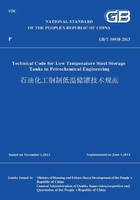
5.2 Primary and Secondary Liquid Containers
Ⅰ Bottom
5.2.1 The annular plates of tank bottom shall have a minimum thickness(excluding corrosion allowance),ta,but not less than 8mm:
(5.2.1)
where:ta——the minimum thickness of annular plate,in mm;
t1——the thickness of the bottom shell course,in mm.
5.2.2 The joint of tank bottom and the bottom shell course shall comply with the following requirements:
1 The minimum width la,between the edge of the sketch plate and the inner side of the shell[see Figure 5.2.2(c)]shall be the value calculated by the following equation or 600mm,whichever is the larger:


Figure 5.2.2 Typical bottom layout
1-Shell;2-Annular plate;3-Sketch plate;4-Backing strip
Where:ta——the thickness of the annular plate,in mm;
H——the maximum design liquid height,in m.
2 The radial joints between annular plates shall be butt welded.
3 Shell to annular plate attachment shall be either or:
1)Butt welded;
2)For the fillet welded at both sides,the maximum height of leg fillets is 12mm.Minimum leg size is the smaller of the shell or the annular plate thickness;
3)Groove weld plus fillet for annular plate greater than 12mm in thickness.The groove depth plus fillet leg shall equal to the annular plate thickness.
4 Annular plate radial joints shall not be located less than 300mm from any vertical shell joint.
5 Minimum distance from outside of the shell plate to the outer edge of the annular plate shall be 50mm.
6 Layouts and details for tank bottom and annular plating shall comply with the requirements in[Figure 5.2.2(a)and Figure 5.2.2(b)].
7 The annular plate width and thickness shall also meet anti-seismic requirements.
5.2.3 The minimum thickness of the bottom plates(excluding corrosion allowance)shall be 5mm,and following requirements shall apply:
1 Minimum length of straight edge of sketch plate shall be 700mm.
2 Sketch plates shall be joined by fillet or butt welding.
3 Lap joints shall have a minimum overlap of five times the thickness of the plate.
4 Fillet welds shall consist of at least two passes.
5 Bottom plates shall be lapped on top of the annular plates,and the minimum lap shall be 60mm.
6 Butt welds in bottom plates shall be welded either from both sides,or from one side using a backing strip.
7 Minimum distance between individual plate joints shall be 300mm.
8 Where reinforcing plates or backing strips are fitted to the bottom plate,continuous fillet welds shall be used.
Ⅱ Tank Shell
5.2.4 The minimum shell plate thickness shall be in accordance with specifications in Table 5.2.4.
Table 5.2.4 Minimum shell plate thickness

Note:The minimum shell plate thickness excludes the corrosion allowance.
5.2.5 The thickness of the shell plate shall be the greatest of the calculated plate thickness td under operating conditions,the calculated plate thickness tt under hydrostatic test condition and the minimum tank shell thickness.The calculated plate thickness td under operating conditions and the calculated plate thickness tt under hydrostatic test condition may be calculated by the following equations:


Where:C——the additional thickness,in mm;
C1——the negative thickness deviation of steel plate,in mm;
C2——the corrosion allowance,in mm;
D——the inside diameter of tank,in m;
td——the calculated wall plate thickness under operating conditions,in mm;
tt——the calculated wall plate thickness under hydrostatic test condition,in mm;
H——the height from the bottom of the course under consideration to the maximum design liquid level,in m;
Ht——the height from the bottom of the course under consideration to the test liquid level,in m;
P——the design pressure,in kPa.0kPa for open top inner tank;
Pt——the test pressure,in kPa.0kPa for open top inner tank;
[σ]d——the allowable design stress of steel plate or weld metal under operating conditions,in MPa;
[σ]t——the allowable design stress of steel plate or weld metal under hydrostatic test condition,in MPa;
ρ——maximum specific gravity of liquid stored;
ρt——maximum specific gravity of test water.
5.2.6 No course shall be designed at a thickness less than that of the course above,except the compression area.
5.2.7 In addition to the requirements specified in Articles 5.2.4-5.2.6,the tank shell shall also comply with the following requirements:
1 All vertical and horizontal welds shall be butt welded for tank shell with full penetration and complete fusion.
2 The distance between vertical joints in adjacent courses shall not be less than 300mm.
3 Where attachments are made,Pad plates shall be used.They shall not be located within 300mm of a vertical weld or 150mm of a horizontal weld.Pad plates and reinforcing plates shall have rounded corners with a minimum radius of 50mm.
4 The inner tank shell subjected to external loading shall be able to withstand the combination of circumferential compressive and axial(longitudinal)stresses.
5.2.8 The design of intermediate ring stiffener shall comply with the following requirements:
1 The transformed shell method may be used to determine intermediate ring stiffener spacing for shells with varying shell thickness.The equivalent height(spacing)between the stiffeners may be calculated by the following equation:

Where:t——the as ordered thickness of each course in turn,in mm;
tmin——the as ordered thickness of the top course,in mm;
h——the height of each course in turn,in m;
He——the equivalent stable height of each course at tmin,in m.
2 Each intermediate horizontal ring stiffener shall be designed to take into account that portion of the shell considered to contribute to the stiffness of that ring.
3 The designs of the shell bottom corner and the top stiffener of an open top tank shall comply with the requirements for end stiffeners or bulkheads.
4 The stiffener shall be connected to the shell with a continuous fillet weld on both sides.A mouse-hole shall be used at intermediate stiffener butt welds and where the stiffener crosses a vertical weld.
5 Stiffeners shall be located at least 150mm from a horizontal weld.
5.2.9 The outer tank shell shall be designed to resist the combination of circumferential and axial(longitudinal)compressive stresses.The shell shall resist a radial pressure caused by the sum of the external wind pressure and vacuum(internal negative pressure).